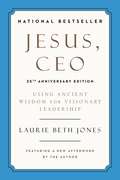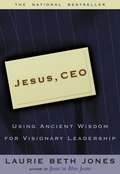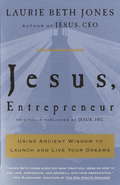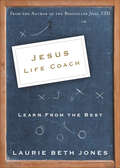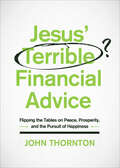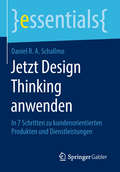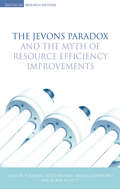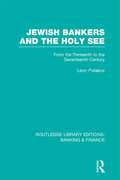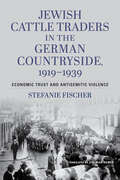- Table View
- List View
Jesus, CEO: Using Ancient Wisdom for Visionary Leadership
by Laurie Beth Jones&“Leaders have a chance, here and now, to create something better than before. We need, like Jesus, to guard our energy. We need to aim for what is noble, not just profitable. We need to become turn-around specialists, seeking better ways of doing things. We need to break ranks and be bold. We need leaders who recognize that we are all connected in a chain of interdependence.&”--from the Afterword by Laurie Beth Jones Bestselling author Laurie Beth Jones brings you the ultimate guide to transforming your team and sparking inspiration in your business—for the new generation of leaders. And who better to learn from than a leader who turned a disorganized staff of twelve into a thriving enterprise that&’s lasted over two millennia? In Jesus, CEO, you&’ll learn how to use ancient wisdom to tap your team&’s energy and intelligence and reinvent your business for a world changing faster than ever.Filled with fresh, practical, and profound advice, Jesus, CEO helps you motivate your team and yourself. Jones divides this advice into three sections: strength of self-mastery, strength of actions, and strength of relationships. By following the leadership techniques of Jesus, you&’ll see that in this hectic, fast-moving business world, the best course is to ground yourself in ancient examples of empathy, integrity, and tenacity.
Jesus CEO: Using Ancient Wisdom for Visionary Leadership
by Laurie Beth JonesFollowing the example of Jesus, a "CEO" who built a disorganized "staff" of twelve into a thriving enterprise, a handbook for corporate success details a fresh, profound approach to motivating and managing others that translates to any business.
Jesús, entrenador para la vida: Aprenda de lo mejor
by Laurie Beth JonesHubo una época en que sólo los atletas tenían entrenadores. Ahora, muchas personas, desde los gerentes hasta los jóvenes en riesgo están siendo "entrenados". La International Coaching Federation, que comenzó con solamente unas pocas personas, hoy tiene más de 5.000 miembros, y más de 150.000 personas se llaman a sí mismas "Entrenadores para la vida". Los beneficios del entrenamiento han sido bien documentados, pero tener el entrenador correcto es crítico.Jesús tuvo solamente tres años para entrenar a los discípulos, pero en ese tiempo él se las arregló para cambiar a ese grupo de pelagatos en "máquinas de mercadeo eficientes y limpias". Dividido en cuatro secciones críticas: enfoque, balance, productividad y cumplimiento, Jesús, entrenador de la vida presenta un programa de entrenamiento basado en la fe, con Jesús como modelo. Investigando a fondo los principios que Jesús usó para transformar a aquellos a su alrededor, este libro ofrece estrategias probadas y numerosas aplicaciones para los entrenadores modernos.
Jesus, Inc.: The Visionary Path, an Entrepreneur's Guide to True Success
by Laurie Beth JonesHe didn't work for money. He was willing to walk away. He invested His emotions wisely. He did sweat the small stuff. Beyond work, beyond entrepreneurism, there is "spiritreneurism" -- work that allows you to do well by doing right. In Jesus, Inc. , Laurie Beth Jones, bestselling author of Jesus, CEO, shows you how to find soul satisfaction in your work. In Jesus, CEO, Laurie Beth Jones offered an irresistible motivational proposition: If Jesus could change the world with a team of just twelve men, shouldn't he have something to teach us all about managing our teams? The answer was a resounding yes, and it made the book a bestseller. Now, in Jesus, Inc., Jones shows that there is no contradiction between earning a comfortable living even as you use your job to promote your deepest spiritual and personal beliefs. How exactly is this possible? Using timeless wisdom from the Bible and anecdotes from her own life and consulting career, as well as tales from the best and worst work situations in today's rapidly changing business environment, she reveals how you can inspire yourself and your coworkers to use your highest gifts to benefit the bottom line. Never before have so many individuals been willing to launch new businesses, and never before have so many of them been looking for a new business model. Here, in Jesus, Inc. , entrepreneurs and "spiritreneurs" will find timeless wisdom and biblical principles that will help create a new world of joyful and satisfying work. A genius at making the powerful familiar, Jones offers a commandingly fresh and compelling case for Jesus as a role model for modern times. Rich with humor, exercises, meditations, and case histories, Jesus, Inc. is essential reading for those seeking to put their spirituality to practical use.
Jesus, Life Coach: Learn from the Best
by Laurie Beth JonesIn the game of life, only one Coach will do.Best-selling author, Laurie Beth Jones takes her uniquely passionate brand of motivational writing to a new level and lays out a faith-based program to get your whole life in shape?with Jesus as your personal trainer.This is your playbook for success?a wealth of information and inspiration that will motivate you to excel in and enjoy all walks of life. Jones, a coach for some of today's leading CEOs, uses her skills and experience to get you thinking, working, and achieving all your goals and dreams.The secret to success can be found, she says, in the most successful man who ever lived?a man who changed the world like no other. And by using Scripture and thought-provoking questions, Jones will show you with practical instructions how to get your life in high gear?at home as well as at work. So don't be left in the stands just watching the game of life when you can become the star pitcher, the starting quarterback, your team's most valuable player.
Jesus' Terrible Financial Advice: Flipping the Tables on Peace, Prosperity, and the Pursuit of Happiness
by John Thornton&“Jesus&’ advice ruined what I planned to write.&” It was the recipe for a great book. John and his wife—both financial experts—had cut their income by 80% to pursue more meaningful lives. Within six years they had two kids, were debt-free, went on several vacations, and doubled their net worth. John was ready to share the biblical principles that made this possible. But he couldn&’t. After reviewing Scripture&’s teaching on money—over 1,300 verses—he realized he had missed something big. Jesus&’ Terrible Financial Advice turns even conventional Christian wisdom on its head. While it answers many of the practical questions we have—like does Jesus want me to be rich or poor? Should I give to everybody who asks? Is it wrong to save?—it goes beyond these concerns. It asks bigger questions, gives bolder answers, and offers a more comprehensive view of stewardship. Follow Jesus&’ &“terrible&” (shocking, otherworldly) financial advice, and you&’ll have what money can&’t buy: purpose.
Jesus' Terrible Financial Advice: Flipping the Tables on Peace, Prosperity, and the Pursuit of Happiness
by John Thornton&“Jesus&’ advice ruined what I planned to write.&” It was the recipe for a great book. John and his wife—both financial experts—had cut their income by 80% to pursue more meaningful lives. Within six years they had two kids, were debt-free, went on several vacations, and doubled their net worth. John was ready to share the biblical principles that made this possible. But he couldn&’t. After reviewing Scripture&’s teaching on money—over 1,300 verses—he realized he had missed something big. Jesus&’ Terrible Financial Advice turns even conventional Christian wisdom on its head. While it answers many of the practical questions we have—like does Jesus want me to be rich or poor? Should I give to everybody who asks? Is it wrong to save?—it goes beyond these concerns. It asks bigger questions, gives bolder answers, and offers a more comprehensive view of stewardship. Follow Jesus&’ &“terrible&” (shocking, otherworldly) financial advice, and you&’ll have what money can&’t buy: purpose.
Jet Propulsion Laboratory
by Robert S. Kaplan Anette MikesThe case, in a non-profit project-oriented setting, introduces fundamental risk management principles and processes that are easily applicable to private sector settings. Gentry Lee, senior systems engineer and de-facto chief risk officer, is applying a new comprehensive risk management system to a $600 million high-profile Mars landing mission. The case illustrates JPL's risk culture for high-visibility and expensive missions in the post-Challenger era with tightly constrained budgets. It introduces risk analytics, such as heat maps, and the management process and governance system centered around continuous challenge and "intellectual confrontation." Students will consider JPL's strategy and constraints, measurable technical risks, non-measurable external risks and societal pressures in making a decision about whether to launch or delay the Mars mission launch. The case calls for an appreciation of the role of the chief risk officer, and in general, of leadership, in risk management.
JetBlue: Prepare for Financing
by Nabil N. El-Hage Darren Smart Christopher E.J. PaytonThe CFO of JetBlue is trying to decide which of two financing proposals to pursue. A straight equity issue will dilute his principal shareholders' ownership, but seems like the safer alternative in an industry that is notorious for its high failure rate. On the other hand, a convertible debt alternative seems less dilutive, and cheaper, but brings with it an increased risk of default and financial problems. Which option should John Owen pursue?
JetBlue: Relevant Sustainability Leadership
by George Serafeim David FreibergIn 2017, JetBlue, the airline founded on the mission to "bring humanity back to air travel", became one of the first companies to report performance according to the Sustainability Accounting Standards Board (SASB) standards and was first among airlines to adopt the recommendations of the Task Force for Climate-related Financial Disclosures. Despite operating as a smaller player in an industry dominated by few legacy competitors, JetBlue saw themselves as a driver of industry progress. However, was JetBlue's leadership "relevant sustainability leadership"? Moreover, how could developing metrics and improved performance on material sustainability issues be used as an instrument for change management? JetBlue wanted to achieve best-in-class performance on SASB metrics, as they believed sustainability was more than simply a risk mitigation tool. Was it? If so, how could JetBlue receive credit from investors, and competitors, for their sustainability leadership?
JetBlue Airways: Deicing at Logan Airport
by Douglas Fearing Robert S. HuckmanThe case explores a deicing capacity expansion decision made by JetBlue at Boston Logan International Airport in the summer of 2010. The need for capacity expansion was driven by significant challenges faced during the previous winter combined with substantial scheduled growth for the upcoming winter.
JetBlue Airways: Starting from Scratch
by Jody Hoffer Gittell Charles A. O'ReillyJetBlue Airways shows how an entrepreneurial venture is able to use human resource management, specifically a values-centered approach to managing people, as a source of competitive advantage. The major challenge faced by Ann Rhoades is to grow this people-centered organization at a rapid rate, while retaining high standards for employee selection and maintaining a small company culture.
JetBlue Airways: Valentine's Day 2007
by Gary P. Pisano Virginia A. Fuller Robert S. HuckmanDescribes an operational crisis for JetBlue Airways during an ice storm in the eastern United States in February 2007 and chronicles the airline's immediate response. Provides detail concerning the history of the airline from its founding in 1999 through the February 2007 crisis, which forced the airline to cancel more than 1,000 flights over the course of six days. In addition, discusses the initial response to the crisis by CEO David Neeleman and his management team. Students are provided with the opportunity to evaluate this response in terms of its impact on customer relations, growth prospects, and ongoing operations for JetBlue.
JetBlue Airways: Managing Growth
by Gary P. Pisano Robert S. HuckmanConsiders the situation facing David Barger, President and CEO of JetBlue Airways, in May 2007 as he addresses the airline's need to slow its growth rate in the response to increasing fuel costs and the effects of major operational crisis for the airline in February 2007. In 2005, JetBlue-typically viewed as a low-cost carrier (LCC)-made a move that is often considered antithetical to the LCC model. Specifically, JetBlue moved from a single aircraft type (i.e., the Airbus 320, or A320) to a fleet with two types of aircraft by adding the smaller Embraer 190, or E190. Students are initially asked to consider the impact of this decision on JetBlue's operations strategy and business model. They are then asked to consider how the reductions in aircraft capacity growth should be spread across the two plane types. This discussion hinges not only on issues of aircraft efficiency but also on those of operational focus and the ultimate competitive priorities of the airline as a whole.
JetBlue Airways: Deicing at Logan Airport
by Douglas Fearing Robert S. HuckmanThe case explores a deicing capacity expansion decision made by JetBlue at Boston Logan International Airport in the summer of 2010. The need for capacity expansion was driven by significant challenges faced during the previous winter combined with substantial scheduled growth for the upcoming winter.
JetBlue: Relevant Sustainability Leadership
by David Freiberg George SerafeimIn 2017, JetBlue, the airline founded on the mission to "bring humanity back to air travel", became one of the first companies to report performance according to the Sustainability Accounting Standards Board (SASB) standards and was first among airlines to adopt the recommendations of the Task Force for Climate-related Financial Disclosures. Despite operating as a smaller player in an industry dominated by few legacy competitors, JetBlue saw themselves as a driver of industry progress. However, was JetBlue's leadership "relevant sustainability leadership"? Moreover, how could developing metrics and improved performance on material sustainability issues be used as an instrument for change management? JetBlue wanted to achieve best-in-class performance on SASB metrics, as they believed sustainability was more than simply a risk mitigation tool. Was it? If so, how could JetBlue receive credit from investors, and competitors, for their sustainability leadership?
JetBlue: Relevant Sustainability Leadership (A)
by David Freiberg George SerafeimIn 2017, JetBlue, the airline founded on the mission to "bring humanity back to air travel", was considering becoming one of the first companies to report its sustainability performance according to the Sustainability Accounting Standards Board (SASB) standards. SASB standards identified climate change, labor issues, and corporate governance issues as important considerations for companies in the airline industry. Despite operating as a smaller player in an industry dominated by few legacy competitors, JetBlue leadership saw the company as a driver of industry progress. However, would the adoption of SASB standards help JetBlue achieve the goal of "relevant sustainability leadership?" How developing metrics and improved performance on material sustainability issues could be used as an instrument for change management? Should Sophia Mendehlson, the Chief Sustainability Officer, integrated Environmental, Social and Governance (ESG) metrics in the regulated fillings as in the 10-K, in separate sustainability reporting mediums, or as a separate report? JetBlue believed sustainability was more than simply a risk mitigation tool. Was it?
Jetzt Design Thinking anwenden: In 7 Schritten Zu Kundenorientierten Produkten Und Dienstleistungen (Essentials)
by Daniel R. SchallmoDas vorliegende essential enthält Grundlagen zu Design Thinking und ein Vorgehensmodell. Das Vorgehensmodell wird einmal überblicksartig mit seinen sieben Phasen und deren Zielsetzung, Aktivitäten, Input und Ergebnissen erläutert. Im Anschluss werden die Phasen mit Leitfragen und relevanten Techniken detailliert behandelt, um so das Vorgehensmodell für Design Thinking verstehen und erfolgreich anwenden zu können. Dies ermöglicht den Leserinnen und Lesern, mittels Design Thinking kundenorientierte Produkte und Dienstleistungen zu gestalten und diese in ein Geschäftsmodell zu integrieren.
Jetzt digital transformieren: So gelingt die erfolgreiche Digitale Transformation Ihres Geschäftsmodells (essentials)
by Daniel R.A. SchallmoIn diesem essential erl#65533;utert Daniel R. A. Schallmo die Digitale Transformation von Gesch#65533;ftsmodellen, dargestellt an drei Beispielen. Ferner zeigt der Autor bestehende Ans#65533;tze zur Digitalen Transformation auf und entwickelt auf dieser Basis eine Roadmap, die ein Vorgehen in f#65533;nf Phasen beinhaltet. Die Digitale Transformation er#65533;ffnet neue M#65533;glichkeiten der Vernetzung und Kooperation unterschiedlicher Akteure, die z. B. Daten austauschen und somit Prozesse ansto#65533;en. In diesem Zusammenhang spielt insbesondere die Digitale Transformation von Gesch#65533;ftsmodellen eine wichtige Rolle, da Gesch#65533;ftsmodelle unterschiedliche Elemente enthalten, die digital transformiert werden k#65533;nnen.
Jetzt digital transformieren: So Gelingt Die Erfolgreiche Digitale Transformation Ihres Geschäftsmodells (Essentials)
by Daniel R. A. SchallmoDaniel R. A. Schallmo erläutert in der 2. Auflage dieses essentials die Digitale Transformation von Geschäftsmodellen, dargestellt an drei Beispielen. Die 1. Auflage wurde überarbeitet und um einen wesentlichen Punkt ergänzt: die Einordnung der Digitalen Transformation von Geschäftsmodellen in den Gesamtkontext der Digitalisierung. Ferner zeigt der Autor bestehende Ansätze zur Digitalen Transformation auf und entwickelt auf dieser Basis eine Roadmap, die ein Vorgehen in fünf Phasen beinhaltet. Neue Möglichkeiten der Vernetzung und Kooperation unterschiedlicher Akteure können eröffnet werden, die z. B. Daten austauschen und somit Prozesse anstoßen. In diesem Zusammenhang spielt insbesondere die Digitale Transformation von Geschäftsmodellen eine wichtige Rolle, da Geschäftsmodelle unterschiedliche Elemente enthalten, die digital transformiert werden können.
The Jevons Paradox and the Myth of Resource Efficiency Improvements (Earthscan Research Editions Ser.)
by Blake Alcott Mario Giampietro Kozo Mayumi John Polimeni?The Jevons Paradox?, which was first expressed in 1865 by William Stanley Jevons in relation to use of coal, states that an increase in efficiency in using a resource leads to increased use of that resource rather than to a reduction. This has subsequently been proved to apply not just to fossil fuels, but other resource use scenarios. For example, doubling the efficiency of food production per hectare over the last 50 years (due to the Green Revolution) did not solve the problem of hunger. The increase in efficiency increased production and worsened hunger because of the resulting increase in population. The implications of this in today?s world are substantial. Many scientists and policymakers argue that future technological innovations will reduce consumption of resources; the Jevons Paradox explains why this may be a false hope. This is the first book to provide a historical overview of the Jevons Paradox, provide evidence for its existence and apply it to complex systems. Written and edited by world experts in the fields of economics, ecological economics, technology and the environment, it explains the myth of efficiency and explores its implications for resource usage (particularly oil). It is a must-read for policymakers, natural resource managers, academics and students concerned with the effects of efficiency on resource use.
Jevons' Paradoxes: William Stanley Jevons and the Roots of Biophysical and Neoclassical Economics (SpringerBriefs in Energy)
by Kent KlitgaardIn 1865, economist William Stanley Jevons published The Coal Question, describing the crucial role that coal played in British economic development. Here, he enunciated what has come to be known as the Jevons paradox, which stated that improvements in resource efficiency leads to greater resource use as the expansion of scale occasioned by lower operating costs overwhelms the savings due to greater efficiency. The implications for any sustainability scenario are enormous and a major theme of this book. While The Coal Question provided the theory that was a precursor to peak oil and resource limits to growth, it was followed six years later by the Theory of Political Economy, the first English-language work of neoclassical economics, which denies the importance of energy as a special commodity. In spite of this apparent contradiction, in this book biophysical economist Kent Klitgaard makes clear that there is no epistemological break between The Coal Question and Theory of Political Economy. Indeed, the Jevons paradox makes little sense in the absence of a behavioral theory grounded in marginal utility, which recognizes the satisfaction that each of us gains as consumers of one more unit of a good or service. Jevons could not solve this paradox in light of his belief that coal mines were becoming exhausted and more expensive to operate, and that there was no substitute for coal. However, he was uninterested in questions of sustainability; rather, he wanted to maintain British industrial and imperial dominance. Did the eventual substitution of oil for coal simply allow us to run through other resources at an accelerated rate? Indeed, the petroleum economy of the 20th and early 21st centuries has presented vastly expanded opportunities for the operation of the Jevons Paradox. This book shows the connections among the different paradoxes in Jevons’ work, and exposes the potentially fatal flaws that confound technological solutions to the sustainability challenge.
The Jewel of Knightsbridge: The Origins of the Harrods Empire
by Robin HarrodIn 1836, Charles Henry Harrod found himself in a prison hulk awaiting transportation to Tasmania for seven years’ hard labour. He had been convicted at the Old Bailey of receiving stolen goods, and this should have been the beginning of the end for his fledgling business and his family. And yet, in miraculously escaping his fate and vowing to turn his back on crime, he would become the much esteemed founder of the now legendary Harrods in London’s fashionable Knightsbridge district. Some years later Charles was succeeded by his son, who brought with him the necessary energy and drive to take the shop from a successful local grocer’s to a remarkable and complex department store, patronised by the wealthy and famous. Robin Harrod’s fascinating family story reveals the previously unknown origins of the store, and follows its remarkable fortunes through family scandal, the devastating fire of 1883 and its subsequent rise from the ashes, to the end of the nineteenth century when its shares were floated on the stock exchange, thus completing one of the most extraordinary comeback stories in the history of commerce.
Jewish Bankers and the Holy See: From the Thirteenth to the Seventeenth Century (Routledge Library Editions: Banking & Finance)
by Leon PoliakovThe Jewish community in Rome is the oldest in Europe, the only one to have existed continuously for over 2,000 years. This detailed study of the Jewish banking community in Italy is therefore of special value and interest. Poliakov’s classic account of the rise and fall of the Jewish bankers is at the same time the story of medieval finance in general, its decline, and the birth of ‘modern’ finance. The author traces the economic and theological implication of each stage in the ambiguous relationship that developed between the Jewish money trade and the Holy See. He shows that the protection enjoyed by the Jews from the Holy See had not only theological, but also economic roots. The study ends with an account of the introduction of modern, ‘capitalist’ techniques and of the consequent inevitable decline of the Jewish money trade.
Jewish Cattle Traders in the German Countryside, 1919–1939: Economic Trust and Antisemitic Violence
by Stefanie FischerJewish Cattle Traders in the German Countryside, 1919–1939, explores the social and economic networks in which this group operated and the informal but durable bonds between Jewish cattle traders and farmers that not even incessant Nazi attacks could break.Stefanie Fischer combines approaches from social history, economic history, and sociology to challenge the longstanding cliché of the shady Jewish cattle dealer. By focusing on trust and social connections rather than analyzing economic trends, Fischer exposes the myriad inconsistencies that riddled the process of expelling the Jews from Germany.Jewish Cattle Traders in the German Countryside, 1919–1939, examines the complexities of relations between Jews and non-Jews who were engaged in economic and social exchange. In the process, Fischer challenges previous understandings of everyday life under Nazi rule and discovers new ways in which Jewish agency acted as a critical force throughout the exclusionary processes that took place in Hitler's Germany.
